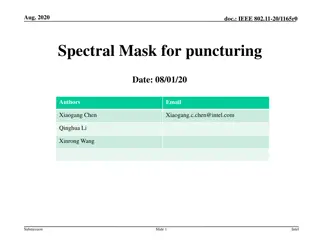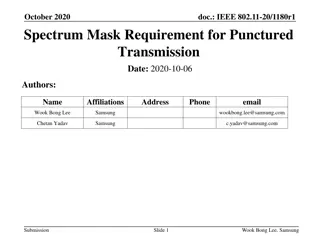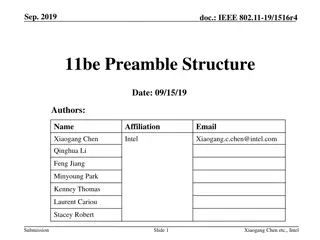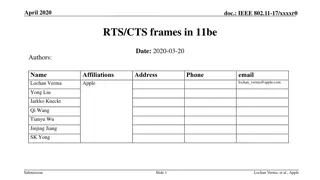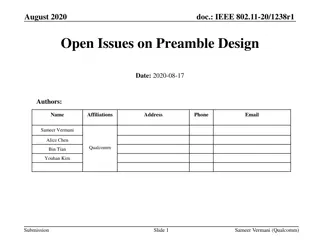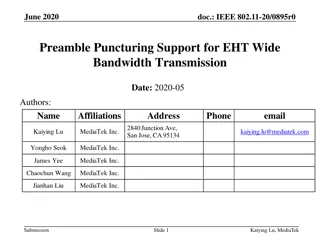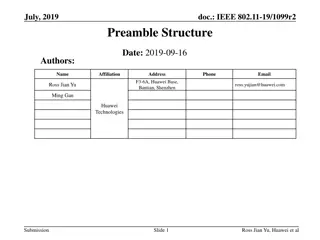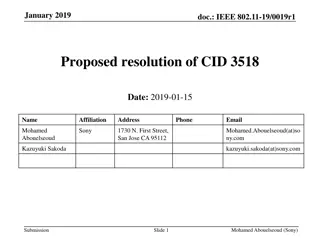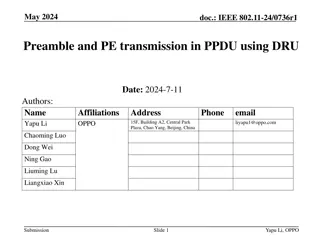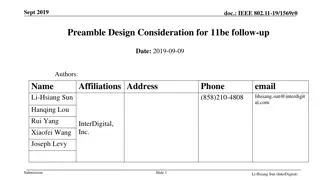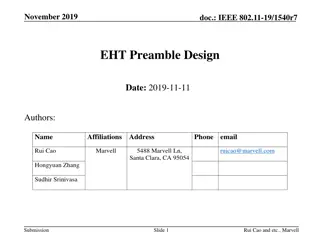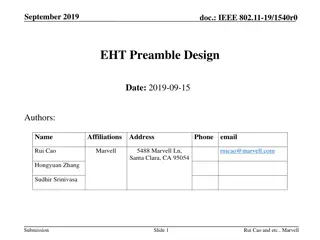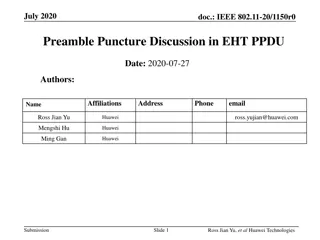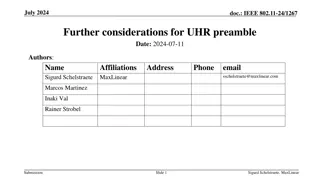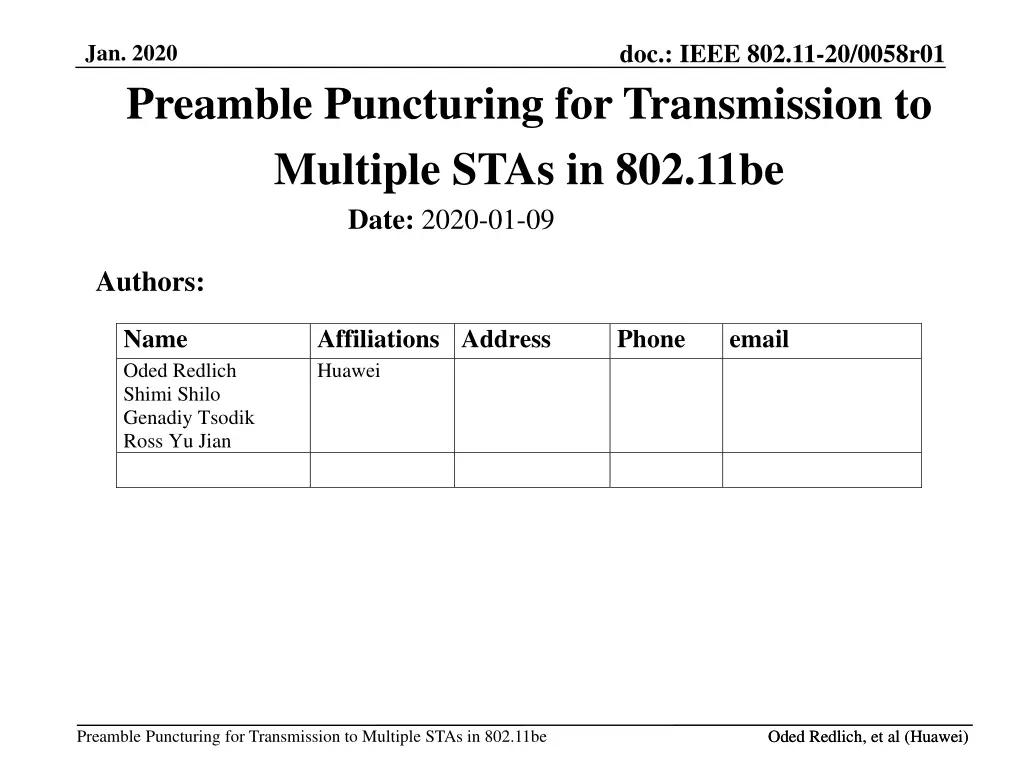
Preamble Puncturing for Multiple STAs in 802.11be
Explore the proposal for improved preamble puncturing in IEEE 802.11be, enhancing transmission to multiple STAs. The suggestion aims to optimize channel bandwidth utilization and signaling efficiency while reducing overhead. Discover the innovative approach presented by Oded Redlich and team from Huawei in this detailed document.
Download Presentation

Please find below an Image/Link to download the presentation.
The content on the website is provided AS IS for your information and personal use only. It may not be sold, licensed, or shared on other websites without obtaining consent from the author. If you encounter any issues during the download, it is possible that the publisher has removed the file from their server.
You are allowed to download the files provided on this website for personal or commercial use, subject to the condition that they are used lawfully. All files are the property of their respective owners.
The content on the website is provided AS IS for your information and personal use only. It may not be sold, licensed, or shared on other websites without obtaining consent from the author.
E N D
Presentation Transcript
doc.: IEEE 802.11-20/0058r01 Jan. 2020 Preamble Puncturing for Transmission to Multiple STAs in 802.11be Date: 2020-01-09 Authors: Name Oded Redlich Shimi Shilo Genadiy Tsodik Ross Yu Jian Affiliations Address Huawei Phone email Preamble Puncturing for Transmission to Multiple STAs in 802.11be Oded Redlich, et al (Huawei) Oded Redlich, et al (Huawei)
doc.: IEEE 802.11-20/0058r01 Jan. 2020 Background: Preamble Puncturing in 11ax In this presentation we aim at improving the preamble puncturing for PPDUs that are transmitted to multiple STAs so they include both U-SIG & EHT-SIG (resembles MU- PPDU in 802.11ax) As decided in the Nov-19 meeting, preamble puncturing shall be supported for transmission to multiple STAs (and for a single STA as well) passed motion in Nov-19 meeting Reminder to 802.11ax puncturing: Puncturing indication exists for P80 only If the two 20MHz channels corresponding to the content-channel that includes S20 (shall be denoted hereafter as the 2ndCC in P80 ) are simultaneously not available (as shown in the figure below) , this content-channel cannot be transmitted, therefore the BW reduces to 20MHz Preamble Puncturing for Transmission to Multiple STAs in 802.11be Oded Redlich, et al (Huawei) Slide 2
doc.: IEEE 802.11-20/0058r01 Jan. 2020 Preamble Puncturing in 802.11be We suggest to overcome the above limitation by allowing all (or most of the) available BW even when the 2nd CC in P80 is not available We can avoid adding too much overhead to U-SIG by maintaining the 11ax puncturing signaling principle signaling principle with minor modifications Assuming U-SIG is duplicated in all 20MHz channels (similarly to HE-SIG-A in 802.11ax), we suggest to add to it puncturing indication about S80 (within P160) In this case, when the 2nd CC in P80 is unavailable, the corresponding CC in S80 is used for extracting the allocation map in the 2nd CC The channel utilization gain is expected to be significant as shown in [1] (up to 42%) and in [2] Preamble Puncturing for Transmission to Multiple STAs in 802.11be Oded Redlich, et al (Huawei) Slide 3
doc.: IEEE 802.11-20/0058r01 Jan. 2020 Preamble Puncturing in 11be In order to save overhead in U-SIG, we suggest not to indicate puncturing outside P160 outside P160 in in it it Why should we refrain from expanding the puncturing indication in U-SIG to other S80s (outside P160)? We can focus on two different cases: Dense environment, where many APs of different BSSs operate simultaneously Sparse environment, where the number of OBSSs is likely to be very low In the next two slides, we give more information about these two cases not to indicate puncturing Preamble Puncturing for Transmission to Multiple STAs in 802.11be Oded Redlich, et al (Huawei) Slide 4
doc.: IEEE 802.11-20/0058r01 Jan. 2020 Preamble Puncturing in 11be - Dense In an unmanaged dense environment (e.g. apartment building), using 320MHz (or even 240MHz) by a given AP is very unlikely. In [3] it is presented that some data collected from a 160MHz capable AP show that 160MHz channel is rarely used, hence it is reasonable to assume that 320MHz and 240MHz will be at least unlikely as well. Hence there is no need to signal puncturing info for the 2nd and/or 3rd S80 (S160/S80 for BW=320MHz/240MHz respectively) in U-SIG and instead it may be signaled in EHT EHT- -SIG by using 242 SIG by using 242- -tone RU empty tone RU empty in the RU Allocation subfield if necessary (similarly to puncturing indication of S80 in 802.11ax). signaled in Preamble Puncturing for Transmission to Multiple STAs in 802.11be Oded Redlich, et al (Huawei) Slide 5
doc.: IEEE 802.11-20/0058r01 Jan. 2020 Preamble Puncturing in 11be - Sparse In a sparse environment, puncturing is unlikely, specifically in S160, due to absence of OBSS in the proximity of the serving AP. When supporting DFS, a long-term/persistent puncturing info (signaled in e.g. the beacon) may/should be applied. In this case, the AP assigns its S160 such that it coincides with the DFS channels, hence in case a Radar is detected, its corresponding channels do not need to be signaled as punctured in U-SIG. Alternatively in a sparse environment, in case persistent puncturing info is not available (not likely), enabling DFS may be planned such that the DFS channel coincides with P160 (so in case a Radar is detected, a puncturing indication exists in U-SIG) and non- DFS channels are used in the S160, hence again, puncturing indication in U-SIG for S160 is not required. Preamble Puncturing for Transmission to Multiple STAs in 802.11be Oded Redlich, et al (Huawei) Slide 6
doc.: IEEE 802.11-20/0058r01 Jan. 2020 Preamble Puncturing in 11be - Signaling The following table suggests the new content of the BW field in EHT-SIG which is increased by 1 bit (relative to HE SIG-A BW field) to support 320MHz (total 4 bits for BW field) BW (4 bits) meaning 0000-0111 Existing modes in 11ax. 1000 Puncturing in 320 MHz: in the primary 80 MHz of the preamble the primary 40MHz is present. 1001 puncturing in 320 MHz, where in the primary 80 MHz of the preamble only the secondary 20 MHz is punctured. 1010 puncturing in 320 MHz, where in the preamble the following 3 20MHz channels are punctured: (1) the secondary 20 MHz (2) the other 20MHz channel corresponding to the same content channel of the secondary 20MHz in P80. (3) the highest 20 MHz channel in S80 corresponding to the same content channel. 1011 puncturing in 320 MHz, where in the preamble the following 3 20MHz channels are punctured: (1) the secondary 20 MHz (2) the other 20MHz channel corresponding to the same content channel of the secondary 20MHz in P80. (3) the lowest 20 MHz channel in S80 corresponding to the same content channel. 1100 puncturing in 160 MHz, where in the preamble the following 3 20MHz channels are punctured: (1) the secondary 20 MHz (2) the other 20MHz channel corresponding to the same content channel of the secondary 20MHz in P80. (3) the highest 20 MHz channel in S80 corresponding to the same content channel. 1101 puncturing in 160 MHz, where in the preamble the following 3 20MHz channels are punctured: (1) the secondary 20 MHz (2) the other 20MHz channel corresponding to the same content channel of the secondary 20MHz in P80. (3) the lowest 20 MHz channel in S80 corresponding to the same content channel. Used channel Legend: 1110 for 320 MHz, 2X160 MHz, and 4X80MHz non-preamble puncturing mode. Punctured channel 1111 Reserved Don t care Preamble Puncturing for Transmission to Multiple STAs in 802.11be Oded Redlich, et al (Huawei) Slide 7
doc.: IEEE 802.11-20/0058r01 Jan. 2020 Conclusions We suggest a puncturing signaling for 802.11be that is based on 802.11ax The 2 main motivations: Overcome the limitation exists in 802.11ax when one of the CC in P80 is punctured Support of BW=320MHz We suggest to add puncturing indication about S80 to U-SIG for PPDUs that are transmitted to multiple STAs The additional overhead in U-SIG is minimal: only 1 additional bit respective to 802.11ax, which yields significant gain in channel utilization We also explained why adding more puncturing signaling about the remaining S80s in U-SIG is not necessary Preamble Puncturing for Transmission to Multiple STAs in 802.11be Oded Redlich, et al (Huawei) Slide 8
doc.: IEEE 802.11-20/0058r01 Jan. 2020 Straw Poll 1 Do you agree that 802.11be should allow (support) 160 and 320 MHz BW when (1) the secondary 20 MHz and (2) the other 20MHz channel corresponding to the same content channel of the secondary 20MHz in P80 are punctured? Y/N/A xx/xx/xx Preamble Puncturing for Transmission to Multiple STAs in 802.11be Oded Redlich, et al (Huawei) Slide 9
doc.: IEEE 802.11-20/0058r01 Jan. 2020 Straw Poll 2 Do you agree to add preamble puncturing indication about S80 for BW=160MHz in U-SIG of a PPDU transmitted to multiple users? Y/N/A xx/xx/xx Preamble Puncturing for Transmission to Multiple STAs in 802.11be Oded Redlich, et al (Huawei) Slide 10
doc.: IEEE 802.11-20/0058r01 Jan. 2020 Straw Poll 3 Do you agree to add preamble puncturing indication about S80 of P160 for BW=320MHz in U-SIG of a PPDU transmitted to multiple users? - Puncturing indication of S160 shall be performed in EHT-SIG Y/N/A xx/xx/xx Preamble Puncturing for Transmission to Multiple STAs in 802.11be Oded Redlich, et al (Huawei) Slide 11
doc.: IEEE 802.11-20/0058r01 Jan. 2020 References [1] 11-19-1190-00-00be-improved-preamble-puncturing-in-802-11be (Oded Redlich et al, Huawei) [2] 11-19-1606-00-00be-Preamble Puncturing and SIG-B Signaling (John Son et al, Wilus Inc) [3] 11-18-1549-00-00be-Recommended Direction for EHT (Brian Hart et al, Cisco) Preamble Puncturing for Transmission to Multiple STAs in 802.11be Oded Redlich, et al (Huawei) Slide 12

